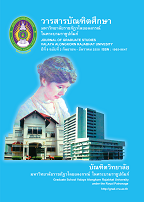การพัฒนารูปแบบการเรียนการสอนพลศึกษาสำหรับนักศึกษาวิชาชีพครูสาขาวิชาพลศึกษาสถาบันการพลศึกษา THE DEVELOPMENT OF INSTRUCTIONAL MODEL FOR PHYSICAL EDUCATION FOR PROFESSIONAL TEACHER STUDENTS IN THE INSTITUTE OF PHYSICAL EDUCATION
Main Article Content
Abstract
บทคัดย่อ
การวิจัยครั้งนี้มีวัตถุประสงค์ 1) เพื่อศึกษาองค์ประกอบการเรียนการสอนพลศึกษาสำหรับนักศึกษาวิชาชีพครู สาขาวิชาพลศึกษา สถาบันการพลศึกษา 2) เพื่อพัฒนารูปแบบการเรียนการสอนพลศึกษาสำหรับนักศึกษาวิชาชีพครู สาขาวิชาพลศึกษา สถาบันการพลศึกษา3) เพื่อศึกษาผลการใช้รูปแบบการเรียนการสอนพลศึกษาสำหรับนักศึกษาวิชาชีพครู สาขาวิชาพลศึกษา สถาบันการพลศึกษาวิธีการดำเนินการวิจัย แบ่งออกเป็น 2 ระยะ คือ ระยะที่ 1 กลุ่มตัวอย่าง ได้แก่ อาจารย์ผู้สอนวิชาพลศึกษา นักศึกษาวิชาชีพครู สาขาวิชาพลศึกษา สถาบันการพลศึกษา จำนวน 450 คน เครื่องมือที่ใช้ในการวิจัยคือ แบบสอบถาม เรื่อง องค์ประกอบการเรียนการสอนวิชาพลศึกษา นักศึกษาวิชาชีพครู สาขาวิชาพลศึกษา สถาบันการพลศึกษา ตรวจสอบคุณภาพแบบสอบถามหาดัชนีความสอดคล้องความตรงเชิงเนื้อหาโดยผู้ทรงคุณวุฒิและ ค่าความเชื่อมั่นโดยใช้ค่าสัมประสิทธิ์แอลฟาตามวิธีของครอนบาคเท่ากับ 0.89 ใช้กระบวนการวิธีวิจัยเชิงสำรวจ วิเคราะห์ข้อมูลโดยสถิติวิเคราะห์องค์ประกอบ ระยะที่ 2 กลุ่มตัวอย่างได้แก่นักศึกษาวิชาชีพครู สาขาวิชาพลศึกษา สถาบันการพลศึกษา ภาคเรียนที่ 2 ปีการศึกษา 2555 ใช้วิธีการสุ่มแบบกลุ่มในการพัฒนารูปแบบการเรียนการสอนและยืนยันรูปแบบโดยการสนทนากลุ่มของผู้เชี่ยวชาญ จัดทำแผนการจัดการเรียนรู้การเรียนรายวิชาเซปักตะกร้อ 1 ตรวจสอบคุณภาพหาค่าดัชนีความสอดคล้องความตรงเชิงเนื้อหาโดยผู้ทรงคุณวุฒิและแบบวัดผลสัมฤทธิ์ทางการเรียน หาค่าความเชื่อมั่นตามวิธีของคูเดอร์–ริชาร์ดสัน (Kuder–Richardson) มีค่าความเชื่อมั่นเท่ากับ 0.90 ค่าอำนาจจำแนกมีค่าระหว่าง 0.81 -0.89และค่าความยาก-ง่าย มีค่าระหว่าง 0.45–0.55 นำแผนการจัดการเรียนรู้ฉบับสมบูรณ์ไปใช้กับกลุ่มตัวอย่าง ระยะเวลาในการทดลอง 16 สัปดาห์ ๆ ละ 3 ชั่วโมงใช้แบบแผนการวิจัยกึ่งทดลองที่มีการควบคุมบางส่วนแบบหนึ่งกลุ่มวัดหลายครั้งทดสอบทักษะกีฬาเซปักตะกร้อก่อนและหลังเรียนทุก 2 สัปดาห์ วิเคราะห์ความแปรปรวนทางเดียวแบบวัดซ้ำ วิเคราะห์ผลสัมฤทธิ์ทางการเรียนตามกรอบมาตรฐาน TQF ก่อนและหลังเรียนโดยใช้ค่าที
ผลการศึกษา พบว่า
1. องค์ประกอบการเรียนการสอนพลศึกษาสำหรับนักศึกษาวิชาชีพครู สาขาวิชาพลศึกษา สถาบันการพลศึกษา ประกอบด้วย 5 องค์ประกอบคือ 1) หลักการ แนวคิด และทฤษฎีการเรียนรู้ 2) วัตถุประสงค์ 3) ขั้นตอนการเรียนการสอน 4) กิจกรรมการเรียนการสอนและ 5) การวัดและการประเมินผล ค่าน้ำหนักแต่ละองค์ประกอบเท่ากับ 0.895, 0.800, 0.811, 0.889 และ 0.843 ตามลำดับ
2. การพัฒนารูปแบบการเรียนการสอน ประกอบด้วย 2.1) การเรียนรู้ด้วยการกระทำหรือการลงมือปฏิบัติจริงทฤษฎีการเรียนรู้ คือ กลุ่มทฤษฎีการสร้างความสัมพันธ์ต่อเนื่องและกลุ่มทฤษฎีการเรียนรู้แบบปัญญา 2.2) วัตถุประสงค์ เพื่อให้ผู้เรียนมีผลสัมฤทธิ์ทางการเรียนด้านคุณธรรมจริยธรรม ด้านความรู้ และการจัดการเรียนรู้ด้านทักษะทางปัญญา รู้จักคิดวิเคราะห์และแก้ปัญหาอย่างเป็นระบบ ด้านทักษะความสัมพันธ์ระหว่างบุคคล มีความรับผิดชอบและส่งเสริมปฏิสัมพันธ์การทำงานร่วมกัน ด้านทักษะ การวิเคราะห์เชิงตัวเลข การสื่อสารและการใช้เทคโนโลยี ด้านทักษะกีฬาและสมรรถภาพทางกาย 2.3) ขั้นตอนการเรียนการสอน 7 ขั้น คือ 1) ขั้นการทำสมาธิ 2) ขั้นการเตรียมความพร้อมและอบอุ่นร่างกาย 3) ขั้นการอธิบายและสาธิต 4) ขั้นการฝึกหัดทักษะ 5) ขั้นการเคลื่อนไหวศึกษา 6) ขั้นการนำไปประยุกต์ใช้และนำเสนองานและ 7) ขั้นสรุปและสุขปฏิบัติ 2.4) กิจกรรมการเรียนการสอนคือการฝึกปฏิบัติสมาธิและการสังเกตพฤติกรรมคุณธรรมจริยธรรม การศึกษาเนื้อหา ประวัติ ทดสอบ อภิปรายความรู้ทางกีฬาและการจัดทำแผนการจัดการเรียนรู้ การคิดวิเคราะห์นำความรู้และทักษะกีฬาไปประยุกต์ใช้ในการแข่งขันและนำเสนองานหน้าชั้นเรียน การจัดทำโครงงานการจัดการแข่งขันทักษะกีฬาแบบกลุ่ม การสร้างโปรแกรมและกำหนดการแข่งขันทักษะกีฬา และการส่งงานผ่านระบบจดหมายอิเลคทรอนิคส์ การฝึกปฏิบัติ ทดสอบทักษะกีฬาและสมรรถภาพทางกาย และ 2.5) การวัดและการประเมินผล ใช้แบบวัดผลสัมฤทธิ์ทางการเรียน 5 ด้านตามกรอบมาตรฐาน TQF และแบบทดสอบทักษะกีฬาและสมรรถภาพทางกาย
3. ผลการใช้รูปแบบการเรียนการสอน ปรากฏดังนี้
3.1 ผลการเปรียบเทียบความแตกต่างด้านคุณธรรมจริยธรรม ด้านความรู้และการจัดการเรียนรู้ด้านทักษะทางปัญญา คิดวิเคราะห์และแก้ปัญหาอย่างเป็นระบบด้านความสัมพันธ์ระหว่างบุคคลความรับผิดชอบและส่งเสริมปฏิสัมพันธ์การทำงานร่วมกันด้านการวิเคราะห์เชิงตัวเลข การสื่อสารและการใช้เทคโนโลยีสารสนเทศและสมรรถภาพทางกาย หลังเรียนสูงกว่าก่อนเรียนอย่างมีนัยสำคัญทางสถิติที่ระดับ .05
3.2 ผลการเปรียบเทียบความแตกต่างคะแนนเฉลี่ยทักษะกีฬาเซปักตะกร้อ มีความแตกต่างกันอย่างมีนัยสำคัญทางสถิติที่ระดับ .05
ABSTRACT
The purposes of this research were 1) to study factors of instructional physical education for professional teacher students in the Institute of Physical Education, 2) to develop instructional model 0f Physical Education for professional teacher students in the Institute of Physical Education, and 3) to study the results of the use of the Instructional model for professional teacher students in the Institute of Physical Education. The research methodology consisted of two phases namely, phase 1 : The sample of this research consisted of 450 lecturers who taught physical education in the Institute of Physical Education. The stated questionnaire was IOC validated by experts, the reliability by Cronbach’s Alpha Coefficient of 0.89. The exploratory research methodology was analyzed by using factor analysis. Phase 2 : The sample consisted of teacher students studying Sepak-takraw 1 in the second semester of the academic year 2555 B.E., obtained by cluster random sampling and confirmed by focus group with experts. This instructional model instrument lesson plan Sepak-takraw was IOC validated by experts and achievement learning test analyzed reliability by Kuder-Richardson, at 0.90, discrimination (r) is between 0.81-0.89 and difficulty between 0.45-0.55.The duration of experimental was 16 weeks, 3 hours per week. Completed instructional model with sample, by using quasi-experiment with One-group Time-Series Design under partial control and repeated measure, ANOVA. Pretest–Posttest sport skills every 2 week, others analyzed achievement learning test by TQF : HEd with t-test dependent.
The results of this research were as follows:
1. The instructional model for professional teacher students in the Institute of Physical Education consisted of five factors : 1) Learning Theory, Concept and Principle, 2) Objectives, 3) Instructional Procedures, 4) Instructional Activity and 5) Measurement and Evaluation. The stated factors had the factor loading as 0.895, 0.800, 0.811, 0.889, and 0.843 respectively.
2. The instructional model development consisted of five factors as follows: 2.1) Learning theory, concept, and principle are conducted by using learning by doing, Association theory, and Cognitive theory. 2.2) The objectives of the learning outcomes included Morality, Knowledge and Learning Management, Cognitive Skill, Critical Thinking and Solving Problems System, Interpersonal Skills and Responsibility, Numerical Analysis, Communication and Information Technology Skills, Sport skills and Physical Fitness. 2.3) The instructional steps consisted of seven steps as follows: Concentration, Warm-Up and Preparation, Demonstration and Explanation, Skills Practice, Movement Education, Application and Presentation and Conclusion and Health Performance. 2.4) Instructional activities refers to teaching and teaching-related activities such as practice concentration, study knowledge history demonstration explanation and management lesson plan on sports, apply and presentation by worksheet, setting project-team sports competition, sports program competition and send with E-mail, sport skills and physical fitness test. 2.5) The measurement and evaluation used achievement learning assessment of five Thai Qualifications Framework for Higher Education, TQF : HEd and Sport Skills and Physical Fitness Test.
3. The results of this instructional model used were as follows:
3.1 The result of the comparison between Pretest and Posttest assessment Morality, Knowledge and Learning Management, Cognitive Skill Critical Thinking and Solving Problems System, Interpersonal Skills and Responsibility, Numerical Analysis, Communication and Information Technology Skills and Sport Skills and Physical Fitness. The scores of the Posttest were significantly higher than those of the Pretest at the level of .05.
3.2 There was significant difference in the comparison of performance skill of Sepak-takraw before between and after experiment were different at the level of significant .05.
Article Details

This work is licensed under a Creative Commons Attribution-NonCommercial-NoDerivatives 4.0 International License.
บทความทุกเรื่องได้รับการตรวจความถูกต้องทางวิชาการโดยผู้ทรงคุณวุฒิ ทรรศนะและข้อคิดเห็นในบทความ Journal of Global of Perspectives in Humanities and Social Sciences (J-GPHSS) มิใช่เป็นทรรศนะและความคิดของผู้จัดทำจึงมิใช่ความรับผิดชอบของบัณฑิตวิทยาลัย มหาวิทยาลัยราชภัฏวไลยอลงกรณ์ ในพระบรมราชูปถัมภ์ กองบรรณาธิการไม่สงวนสิทธิ์การคัดลอก แต่ให้อ้างอิงแหล่งที่มา


